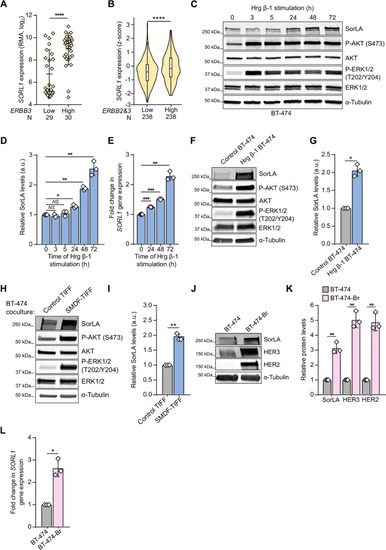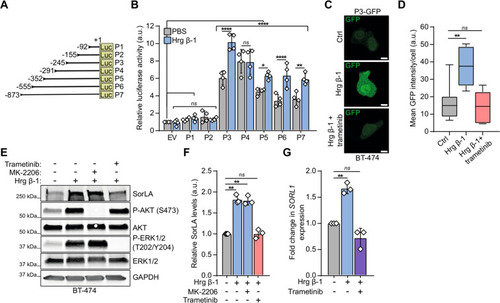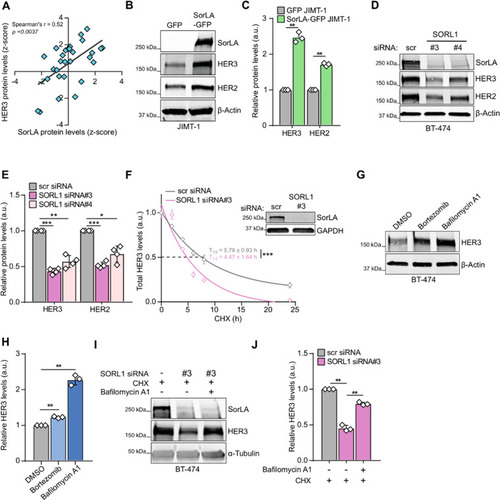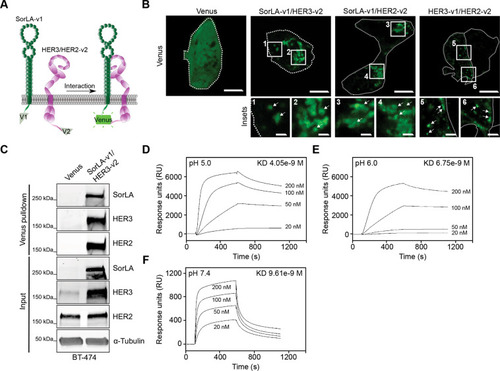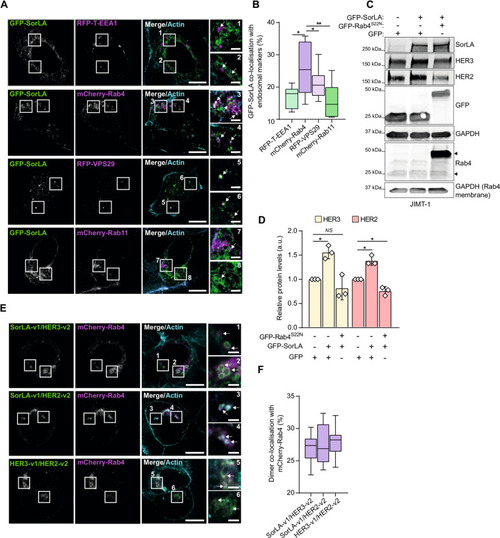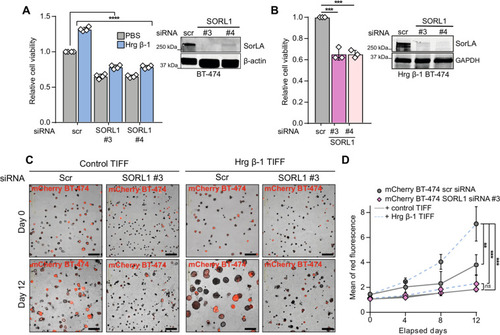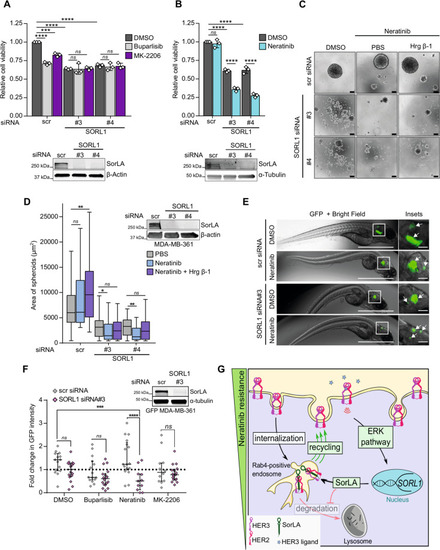- Title
-
A feed-forward loop between SorLA and HER3 determines heregulin response and neratinib resistance
- Authors
- Al-Akhrass, H., Conway, J.R.W., Poulsen, A.S.A., Paatero, I., Kaivola, J., Padzik, A., Andersen, O.M., Ivaska, J.
- Source
- Full text @ Oncogene
|
|
|
|
|
A SorLA and HER3 protein levels correlate positively in breast cancer cell lines (DepMap portal; N = 29). B–E HER3 and HER2 expression correlates with SorLA in HER2-positive breast cancer. B, C SorLA-GFP transfection in JIMT-1 cells increases HER2 and HER3 levels compared to GFP transfected cells. D, E. SorLA silencing in BT-474 cells decreases HER2 and HER3. B, D Representative immunoblotting of total HER2, HER3, and SorLA with β-actin as a loading control. C, E represent the respective quantifications of immunoblots in (B, D) with HER2/HER3 levels normalized to loading control and relative to control-silenced cells. F SorLA silencing decreases HER3 stability. RNAi transfected BT-474 cells were treated with 25 µg.mL−1 of CHX for the indicated time points and HER3 protein levels were determined by immunoblotting (see Fig. S3E). Shown are HER3 levels normalized to α-tubulin and relative to 0 h timepoint. Half-lives (T1/2) represent the time required for HER3 to decrease to 50% of its initial level. The least squares fitting method and extra-sum-of-squares F test were used to assess the statistical difference between curves from control and SorLA-silenced cells (P = 0.0002). A representative western blot validating SorLA silencing is shown. G HER3 is primarily degraded through the lysosomal pathway. BT-474 cells were treated with 1 µM of bortezomib or 50 nM of bafilomycin A1 for 4 h to inhibit proteasome and lysosome activities, respectively. HER3 expression was analyzed by immunoblotting, with α-tubulin as a loading control. H Quantification of HER3 levels normalized to loading control and relative to DMSO-treated control cells. I SorLA silencing triggers HER3 lysosomal degradation. SorLA-silenced BT-474 cells were cotreated for 4 h with CHX and bafilomycin A1. HER3 expression was analyzed by immunoblotting, with α-tubulin as a loading control. J Quantification of HER3 levels normalized to loading control and relative to CHX-treated control-silenced cells. Data are mean ± SD from three (C, F, H, J) or four (E) independent biological replicates. Statistical analyses: Student’s t test (unpaired, two-tailed, unequal variance) unless indicated otherwise. Scr: control non-targeting siRNA. |
|
A A scheme depicting BiFC between SorLA-v1 and HER2/3-v2. B The indicated BiFC dimers were expressed in BT-474 cells and their interaction was assessed through imaging of reconstituted Venus. Cells are outlined with white dotted lines. Shown are representative confocal microscopy images and a control Venus-expressing cell showing diffuse fluorescence localization. Scale bars (main): 10 µm. Scale bars (insets): 2 µm. C Venus or SorLA-v1/HER3-v2 were transiently expressed in BT-474 cells. Cell lysates were subjected to nanobody pulldown (specific for the reconstituted Venus v1 + v2 dimer) and pulldowns and total cell lysates (input) were immunoblotted with the indicated antibodies. D–F. SorLA interacts with HER3 in a pH-dependent manner. SPR analysis on immobilized SorLA and a 20–200 nM concentration series of HER3 at pH 5.0 (D), 6.0 (E) and 7.4 (F). KD: equilibrium dissociation constant. Data are representative of three independent biological replicates. |
|
A Representative Airyscan confocal microscopy images of BT-474 cells coexpressing GFP-SorLA with the indicated endosomal markers. SiR-Actin was used for counterstaining the actin cytoskeleton. White arrows depict colocalizing signals. Scale bars: 10 µm. Scale bars (insets): 2 µm. B GFP-SorLA strongly colocalizes with mCherry-Rab4 in BT-474 cells. Colocalization was calculated (see “Methods”) from BT-474 cells transfected and imaged as in (A). N = 36 cells per group. C JIMT-1 cells were cotransfected with GFP-SorLA and either GFP control or GFP-Rab4S22N dominant-negative mutant. Representative immunoblotting of SorLA, HER2, HER3, GFP, and Rab4, with α-tubulin as a loading control. GFP immunoblot detects GFP control and GFP-Rab4S22N proteins. The higher molecular weight GFP-SorLA was probed with anti-SorLA primary antibody. In the Rab4 immunoblot, the upper arrowhead indicates GFP-Rab4S22N and the lower arrowhead the endogenous protein. D Quantification of HER2 and HER3 levels normalized to loading control and relative to control GFP-transfected cells. E Representative confocal microscopy images of BT-474 cells co-overexpressing mCherry-Rab4 with the indicated BiFC dimers. SiR-Actin was used for counterstaining the actin cytoskeleton. White arrows depict colocalizing signals. Scale bars: 10 µm. Scale bars (insets): 2 µm. F Colocalization analysis between BiFC and mCherry-Rab4. N = 30 cells per group. D Data are mean ± SD from three independent biological experiments; statistical analysis: Student’s t test (unpaired, two-tailed, unequal variance). B and F Box plots represent median and 25th and 75th percentiles (interquartile range), and whiskers extend to maximum and minimum values; three biological replicates. Statistical analysis: One-way ANOVA, Dunn’s multiple comparisons test. |
|
|
|
|

